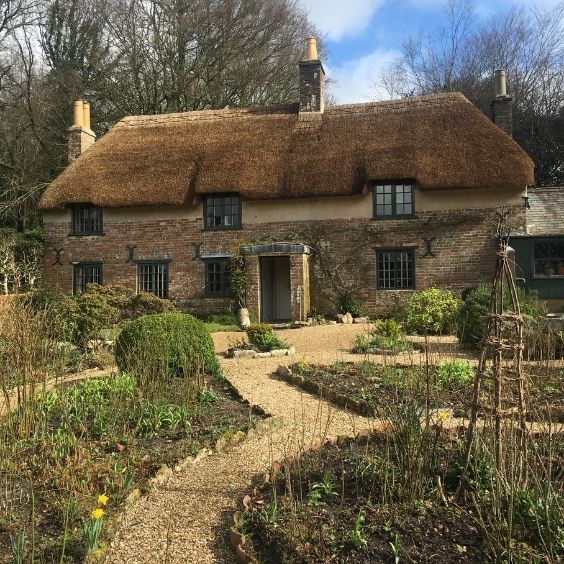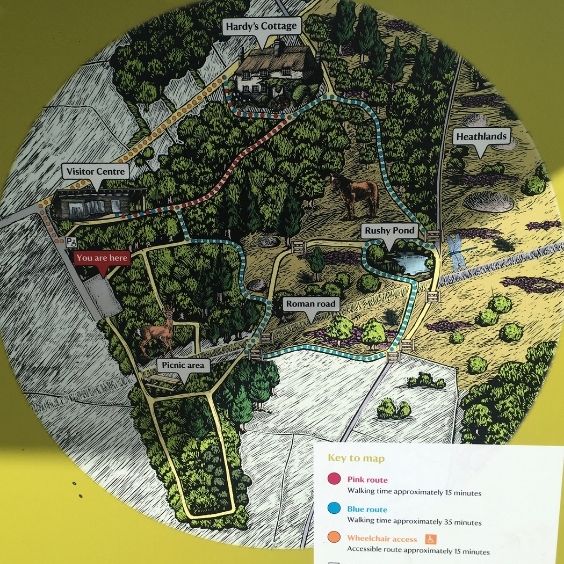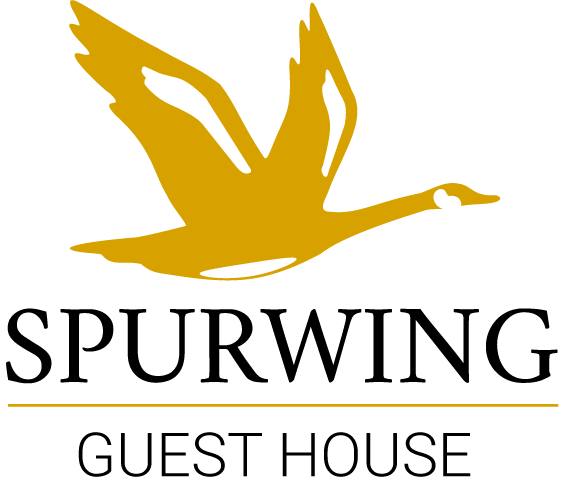Exploring Thomas Hardy’s Dorset is a must for any present or future Hardy book enthusiast. He is Dorset’s most celebrated writer.

Thomas Hardy’s Cottage
Hardy was born in Dorset and lived there for much of his life, drawing inspiration from the rural landscape he named ‘Wessex, the name he later also gave to his beloved, ill-tempered fox terrier dog.
He was born in 1840 in a cob and thatched cottage in Higher Bockhampton which his grandfather built, pictured above.
He lived there with his family until his marriage to Emma Gifford at the age of thirty-four.
Hardy’s Cottage is nestled in beautiful Dorset countryside and owned by the National Trust. Thorncombe Wood, beside the cottage, was his childhood playground which he no doubt regularly explored with his three younger siblings, Mary, Henry and Katherine.
The National Trust have selected favourite routes through the landscape to help visitors explore and discover this special location.

The furniture in Thomas Hardy’s cottage, although not of the family, is from that time.



It was in this cottage that Hardy wrote two of his most popular novels, Under the Greenwood Tree and Far from the Madding Crowd.
Max Gate
Pictured below is Max Gate, just outside Dorchester. Hardy designed this house and had it built for himself and his wife Emma Gifford. They moved here in 1885.
One of Hardy’s most controversial works, Tess of the D’Urbervilles, was written at Max Gate.


His wife Emma died in 1912. At this point, husband and wife were estranged, both living separate lives at Max Gate.
Despite Emma and Hardy’s estranged lives, Hardy found Emma’s death incredibly affecting, and was filled with sadness and guilt. These feelings manifest themselves in Hardy’s collection of love poems from 1912-1913.
Following her death, Hardy married Florence Dugdale in 1914. She had met Hardy several years earlier whilst he was married to Emma, and had soon become friends with the couple, working as Hardy’s part-time secretary.
Hardy lived in this house until his death in 1928. Max Gate is looked after by the National Trust and open to the public. It was bequeathed to them by Hardy’s sister. Like Hardy’s Cottage, most of the furniture, although not of the family, is from that time.


Saint Michael’s Church
Thomas Hardy’s wishes were that he was to be buried with his parents at the 13th Century medieval church of Saint Michael in Stinsford, quite close to Thomas Hardy’s Cottage.
 Hardy’s connection with Stinsford was a strong one. Saint Michael’s was his parish church. He was baptised in the font, and he attended services here and later taught Sunday School.
Hardy’s connection with Stinsford was a strong one. Saint Michael’s was his parish church. He was baptised in the font, and he attended services here and later taught Sunday School.
The authorities at Westminster Abbey suggested that he be buried in ‘Poet’s Corner’. Faced with this dilemma his second wife Florence decided that his heart be buried in Stinsford and his ashes be interred in the Abbey.
If you are interested in reading about Saint Michael’s Church in Stinsford and other local Dorset churches, please link to the blog on our website here: https://www.spurwing.info/5-local-churches-in-dorset/

Athelhampton House
Finally when exploring Thomas Hardy’s Dorset, the wonderful 15th Century manor, Athelhampton House, is another interesting place open to the public. Hardy visited here many times and his father, a stonemason, worked on the house. Hardy was visiting Athelhampton when news of the war was announced in 1914.
 If you enjoyed reading this blog and would like to learn about updates, events in the area or last-minute availability at our Dorset B&B, Spurwing Guest House, you can subscribe to our mailing list: https://eepurl.com/gWilmz
If you enjoyed reading this blog and would like to learn about updates, events in the area or last-minute availability at our Dorset B&B, Spurwing Guest House, you can subscribe to our mailing list: https://eepurl.com/gWilmz









